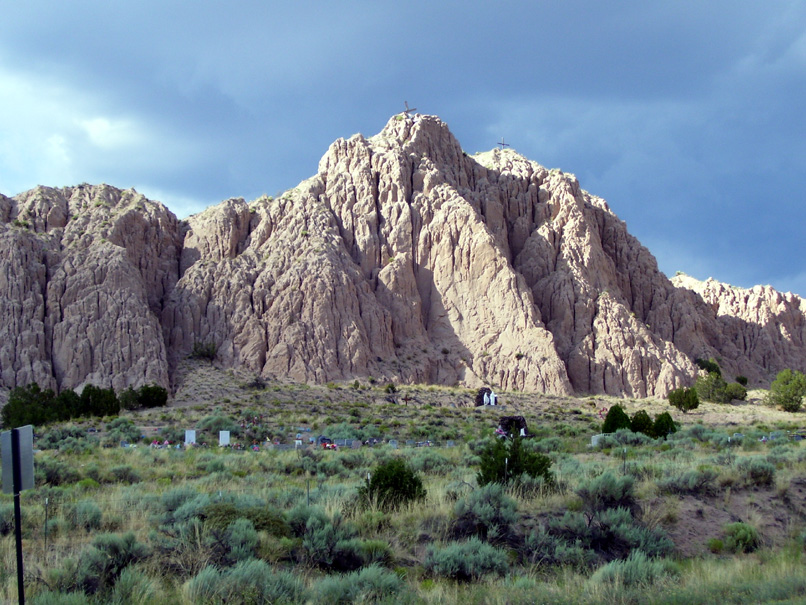

A couple of months ago Mrs NRVO issued an
Imperial Decree: before my classes started in the Fall semester, we were going to Santa Fe, NM. This was, ostensibly, to visit my
god-daughter who moved there 2 years ago, when her husband got a faculty job at
St John’s College; but also because it was one of five states She
hadn’t yet been to, and She wants to hit all 50 of them. Not that I needed too much convincing, since it was a chance to see Carolyn and her
family in their new home. Though it's
very different from their last home (
We flew into
 We stayed mostly at Best Westerns, a chain we’ve used for many years: but I
will state here and now that I heartily advise anyone contemplating staying at
a Best Western facility to reconsider. In the past five
We stayed mostly at Best Westerns, a chain we’ve used for many years: but I
will state here and now that I heartily advise anyone contemplating staying at
a Best Western facility to reconsider. In the past five 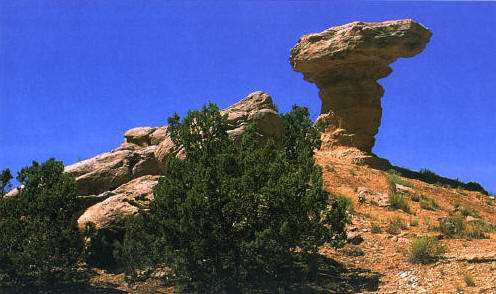 years or so their hotels have really gone downhill. The rooms we got were shabby and the hotel
and grounds maintenance lousy. It was hard to find hotel rooms for the
dates we wanted, so with some misgivings we booked at a BW in
years or so their hotels have really gone downhill. The rooms we got were shabby and the hotel
and grounds maintenance lousy. It was hard to find hotel rooms for the
dates we wanted, so with some misgivings we booked at a BW in
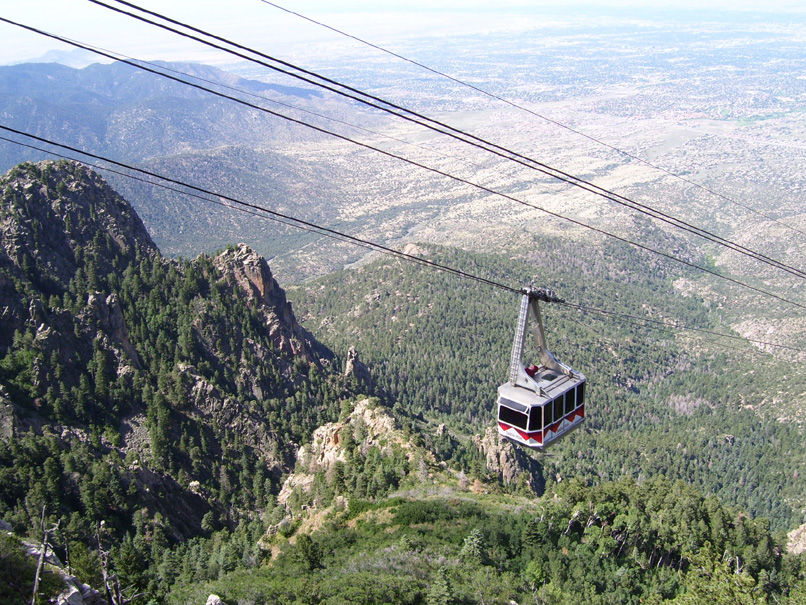
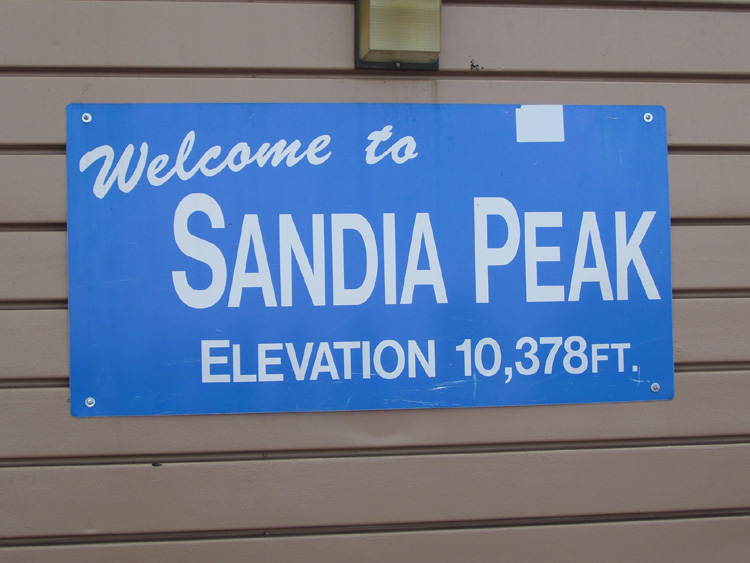 The next day after arriving in
The next day after arriving in
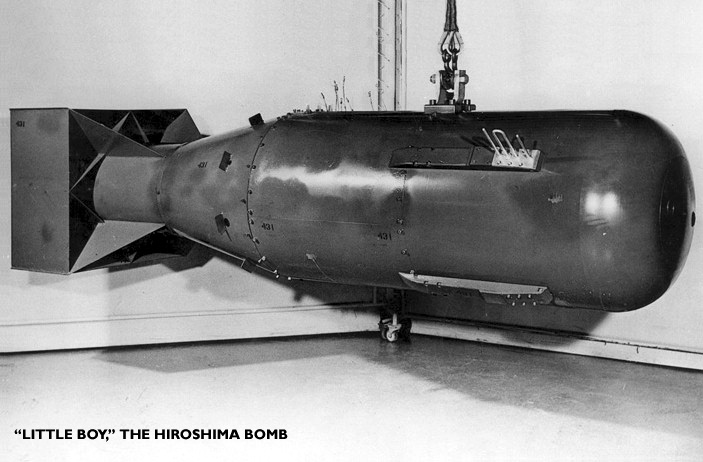
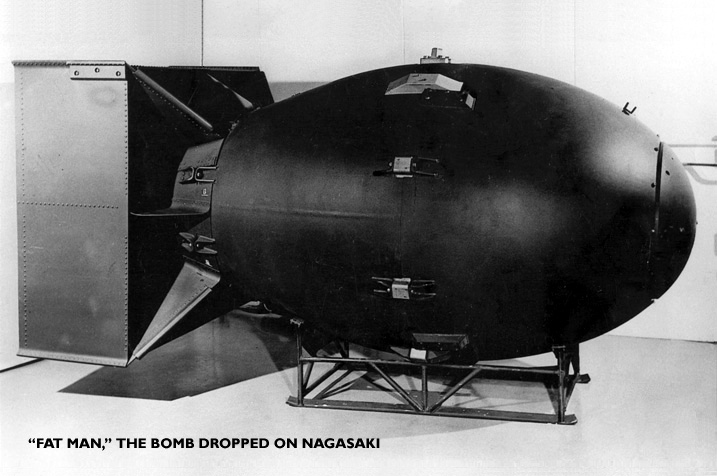 Regrettably, they also have had to concede space to a cadre of "peace
groups" who have posted a wall-sized display on Why The Bomb Was Inhumane
And Should Never Have Been Used, and Why Truman Was A Murderer, and Why It Was
All Really Unnecessary, and how We Should Give Peace A Chance, and All Join
Together To Work For Peace, All Join Hands And Sing Kumbaya, and similar left-wing bullshit. Anyone who has read anything at all about the Pacific War knows
perfectly well that the Japanese would have died to the last woman and child
rather than surrender, absent an order to do so from the Emperor; and that
Truman's decision shortened the war by at least two years and saved at least
2,000,000 lives, American AND Japanese. The museum was
strong-armed into mounting this idiotic display: but to their credit, they put up an
even better one right next to it explaining what exactly was going on
before and during the war, detailing the many Japanese atrocities and the
fanaticism of the Japanese militarists and cabinet who simply didn't concede
the possibility of surrender and refused to contemplate it; and explaining why
the decision HAD to be to use the bombs.
Regrettably, they also have had to concede space to a cadre of "peace
groups" who have posted a wall-sized display on Why The Bomb Was Inhumane
And Should Never Have Been Used, and Why Truman Was A Murderer, and Why It Was
All Really Unnecessary, and how We Should Give Peace A Chance, and All Join
Together To Work For Peace, All Join Hands And Sing Kumbaya, and similar left-wing bullshit. Anyone who has read anything at all about the Pacific War knows
perfectly well that the Japanese would have died to the last woman and child
rather than surrender, absent an order to do so from the Emperor; and that
Truman's decision shortened the war by at least two years and saved at least
2,000,000 lives, American AND Japanese. The museum was
strong-armed into mounting this idiotic display: but to their credit, they put up an
even better one right next to it explaining what exactly was going on
before and during the war, detailing the many Japanese atrocities and the
fanaticism of the Japanese militarists and cabinet who simply didn't concede
the possibility of surrender and refused to contemplate it; and explaining why
the decision HAD to be to use the bombs.
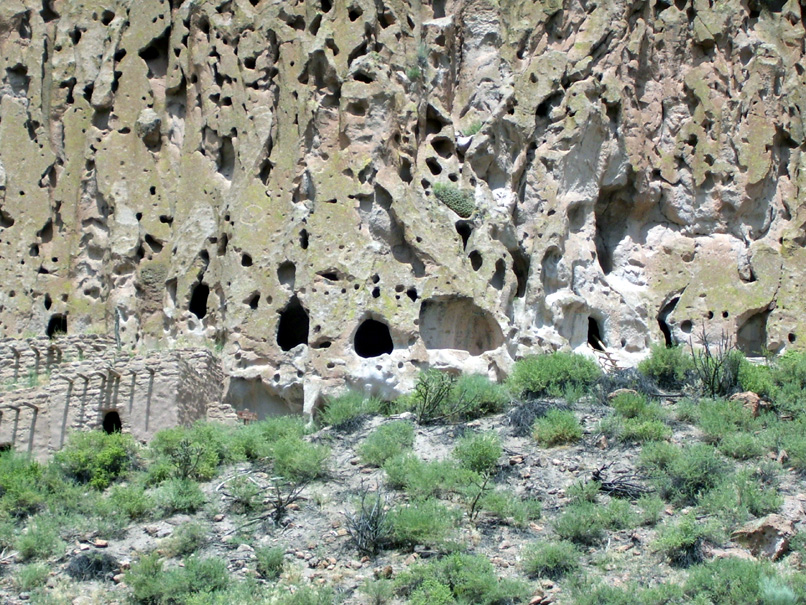
After this brief diversion into a place that changed the world, we went on to see 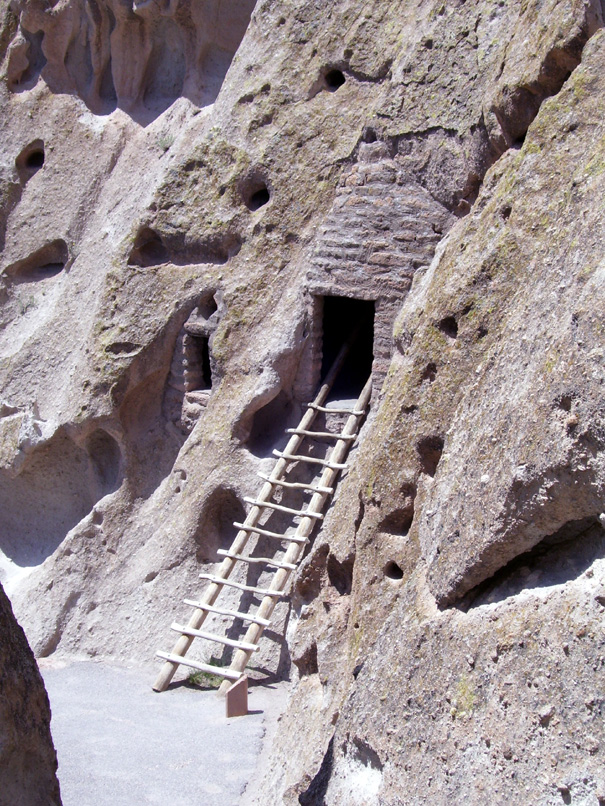 relatively safe from predators and enemies, while the plebeians lived in the
lower town, where they may have had access to water (one of their jobs would
have been to carry it up the cliffs, no doubt) but were far more exposed to
being killed or eaten. You can’t make an omelet without breaking eggs,
and sacrificing a few low-status Anasazi to the mountain lions so that the
high-status Anasazi could have the chance to breed, well, it’s perfectly
understandable, isn’t it?
relatively safe from predators and enemies, while the plebeians lived in the
lower town, where they may have had access to water (one of their jobs would
have been to carry it up the cliffs, no doubt) but were far more exposed to
being killed or eaten. You can’t make an omelet without breaking eggs,
and sacrificing a few low-status Anasazi to the mountain lions so that the
high-status Anasazi could have the chance to breed, well, it’s perfectly
understandable, isn’t it?
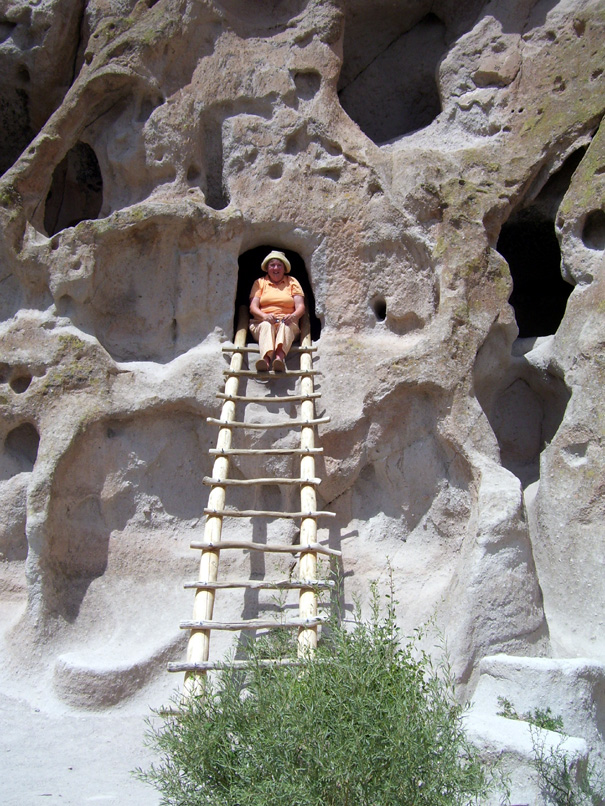 You could climb ladders into the caves, which Mrs NRVO dutifully did, but inside each was just a hole in the rock; even
if it was "uptown," the Anasazi equivalent of a Park Avenue
penthouse.
You could climb ladders into the caves, which Mrs NRVO dutifully did, but inside each was just a hole in the rock; even
if it was "uptown," the Anasazi equivalent of a Park Avenue
penthouse.
Imagine a life with no metal: these people had to chop down trees and shape stuff with rocks, skin animals with flint chips, and carry water in dirty skin bags. They had fire (so long as they didn't let it go out) and some primitive "technology" but it was so hard a life (even if you were one of the high-roller Anasazi) that at no time did the population of the area exceed 700. Usually it was far lower.
They died from everything except old age: snakebite, animal attacks, Navajo arrows, falling out of a cave while trying to take a piss in the night, childbirth, infections, incapacitating injuries, starvation, overwork, insect-borne disease, rocks falling on their heads, parasites, poisonous plants, you name it. Life span was on the order of 35: a man 45 years old was probably the Tribal Elder, whose memory was as far back as their history went. Infant mortality was likely 80% in the first year. No doubt there were more men than women because the women died in childbirth or were worked to death and a man would change wives about as often as he'd have changed shirts, if he wore shirts, which of course the Anasazi didn't.
By the way, you're not supposed to call them "Anasazi" anymore, that's Politically Incorrect. “Anasazi” is a Navajo term that means "Nasty Old Ones," and it's a no-no. You can call them "The Old Ones," or "The Ancient Ones," but no impression of nastiness can be attached to them, even though there aren't any left.
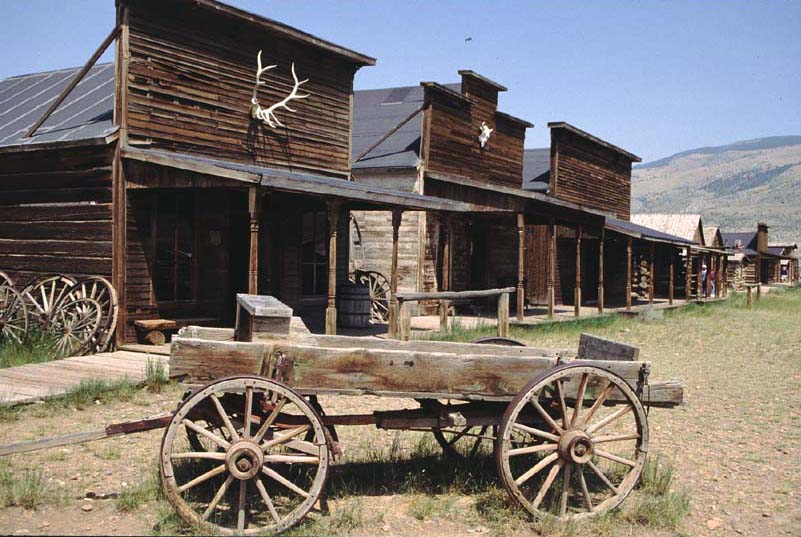 Somewhere along the way between
Somewhere along the way between
It
was in Madrid that I had my first inkling that the population of
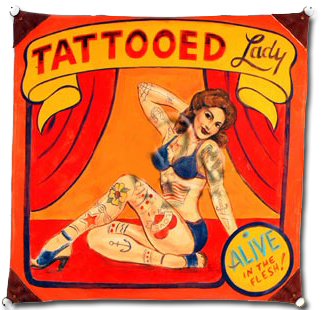 Organically-Grown coffee beans,
obtained in a Fair Trade purchase from Native Peoples, who absolutely had produced
the bean using Sustainable Agriculture Methods. The wait-person was a
woman about 5 years younger than I, wearing a tie-dyed skirt and copper
bangles, looking as if she'd been transported through time from the Greenwich
Village "coffee houses" of my long-dead youth. No doubt she was
wearing the same clothing in 1967.
Organically-Grown coffee beans,
obtained in a Fair Trade purchase from Native Peoples, who absolutely had produced
the bean using Sustainable Agriculture Methods. The wait-person was a
woman about 5 years younger than I, wearing a tie-dyed skirt and copper
bangles, looking as if she'd been transported through time from the Greenwich
Village "coffee houses" of my long-dead youth. No doubt she was
wearing the same clothing in 1967.
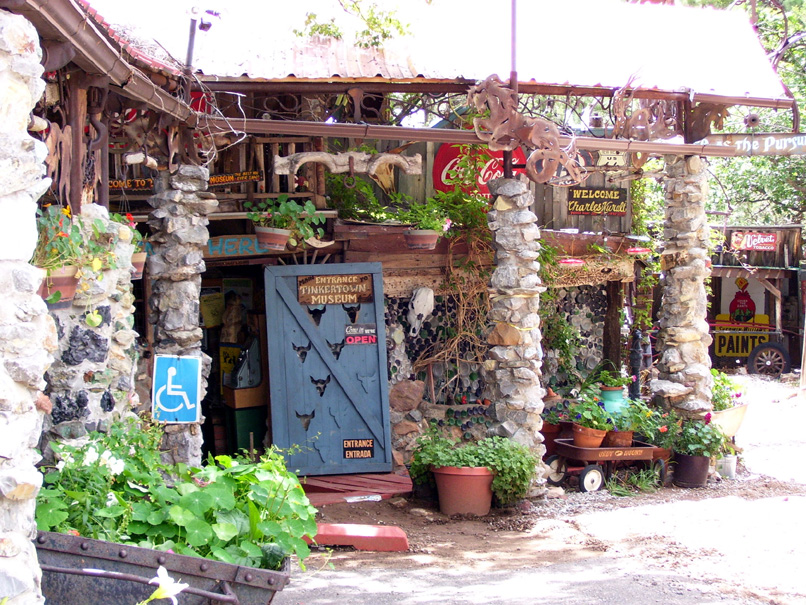
We stopped at a place that is barely beyond my ability to describe adequately. It was the life's work of a gentleman who could have been the Poster Child for both Obsessive-Compulsive Disorder and Tourette's Syndrome. This incomparable place, this Tourist-Trap-To-Top-All Tourist Traps, the trappo di tutti trappi, is Tinkertown. 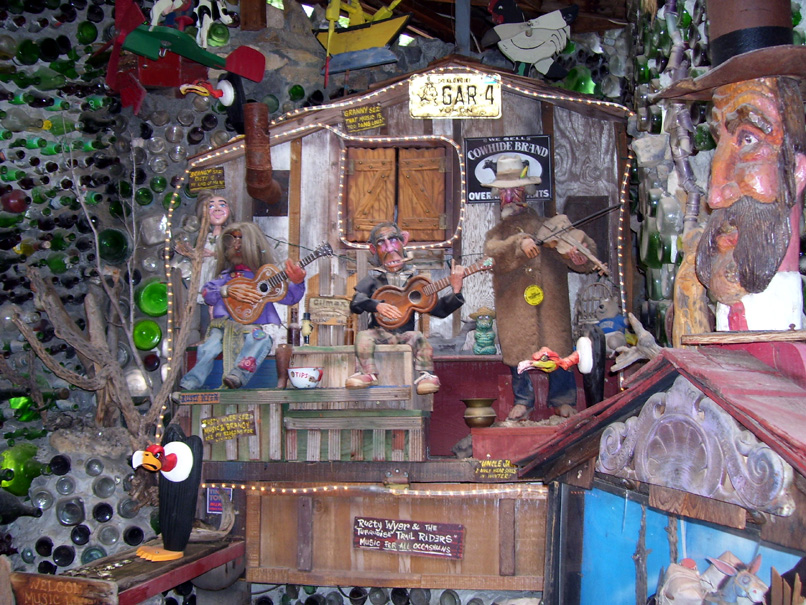 Honestly, no mere verbal description can do it justice, but I'll try.
Honestly, no mere verbal description can do it justice, but I'll try.
Tinkertown is a vast collection of hand-carved objects, all of them made by one amazing man, Ross Ward, who must never have slept, since he must have been carving 24/7. Thousands upon thousands of his folk-art figures are arranged in miniature dioramas of western towns, circus scenes, mining camps, most of them animated. Push a button and the blacksmith hammers a horseshoe, the horse stamps his hoof, the loafers on the porch of the saloon hoist their beer, and the necktie-party Guest of Honor drops through the gallows trap. Dogs lift their legs, mules kick, and dance hall gals flirt.
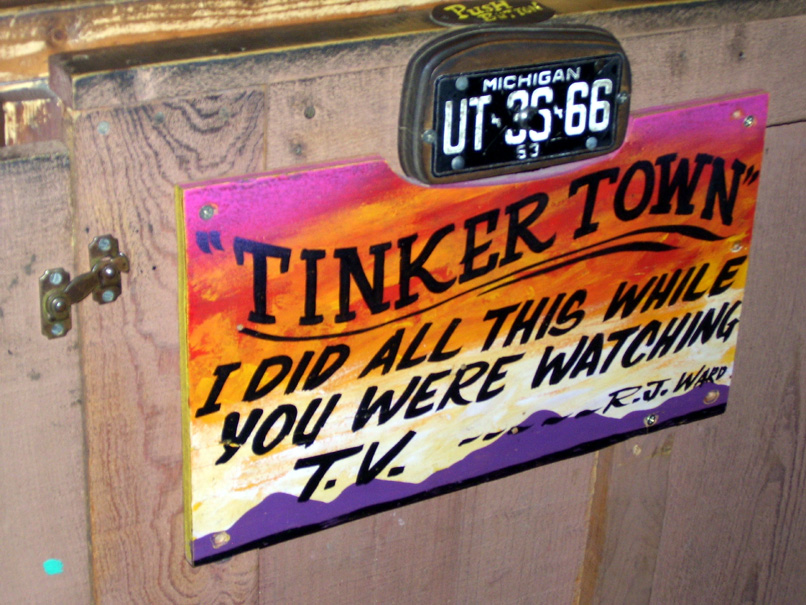 Quite aside from being a skilled carver, Ward was a world-class pack rat. The wall around the place is made of old bottles. The floors are somewhat uneven,
Quite aside from being a skilled carver, Ward was a world-class pack rat. The wall around the place is made of old bottles. The floors are somewhat uneven, 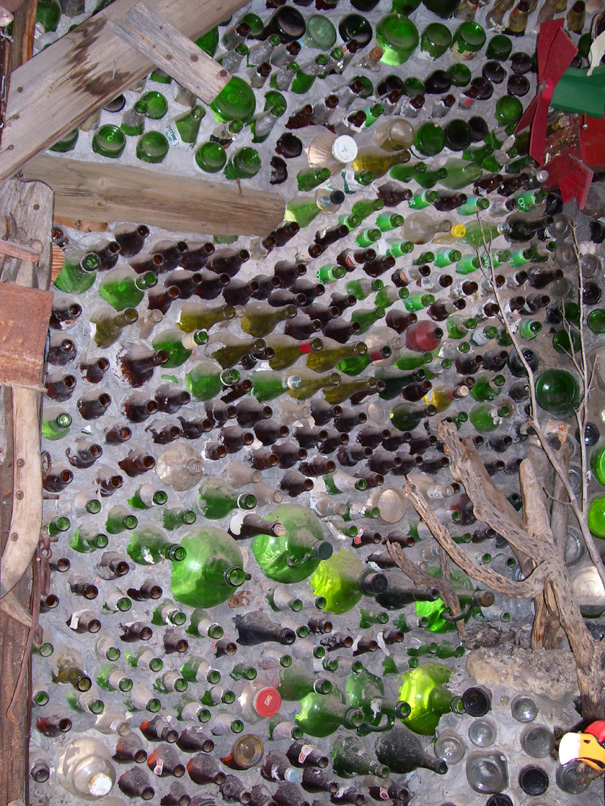 so where there was a slope he nailed old license plates. Everything got used somehow, even if he had to collect more junk to make a place for the original junk. One end of the complex is dedicated to the preservation of a sailboat, Theodora R. Some zany spent 10 years sailing around the world in the 1930's. Ward bought it for his collection and it's proudly housed in its own annex, in Perpetual Drydock.
so where there was a slope he nailed old license plates. Everything got used somehow, even if he had to collect more junk to make a place for the original junk. One end of the complex is dedicated to the preservation of a sailboat, Theodora R. Some zany spent 10 years sailing around the world in the 1930's. Ward bought it for his collection and it's proudly housed in its own annex, in Perpetual Drydock.
There's a wonderful collection of side-show 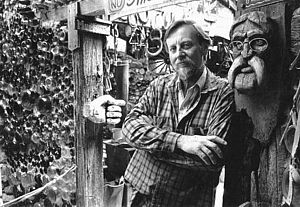 and amusement park games, such as Fortune-Telling Gypsy Grandmother Robots, Strength Testers, Love Meters, and carousel horses. Ward was "into" Circusiana as well: his collection of hand-made stuff is matched in size by the circus-related toys, games, objects, and paraphernalia that take up one "wing" of this ramshackle place. Ward died in 2002, but his family carries on his legacy by maintaining (and, I suppose, increasing the size of) the collection. Si monumentum requires, circumspice: Tinkertown is a memorial to one man's dream and his lifelong obsession.
and amusement park games, such as Fortune-Telling Gypsy Grandmother Robots, Strength Testers, Love Meters, and carousel horses. Ward was "into" Circusiana as well: his collection of hand-made stuff is matched in size by the circus-related toys, games, objects, and paraphernalia that take up one "wing" of this ramshackle place. Ward died in 2002, but his family carries on his legacy by maintaining (and, I suppose, increasing the size of) the collection. Si monumentum requires, circumspice: Tinkertown is a memorial to one man's dream and his lifelong obsession.
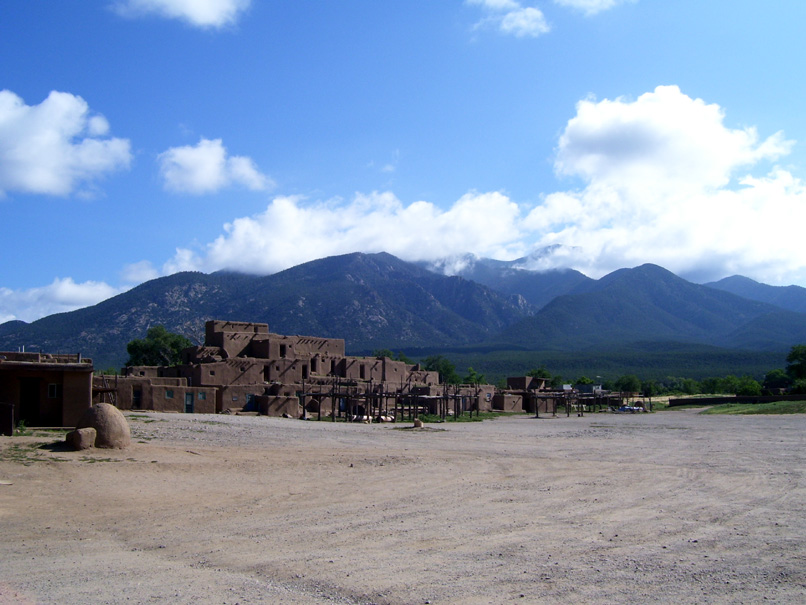
The pueblo (aka a reservation) was very interesting. It’s a World
Heritage Site, and could be fairly called the nucleus of
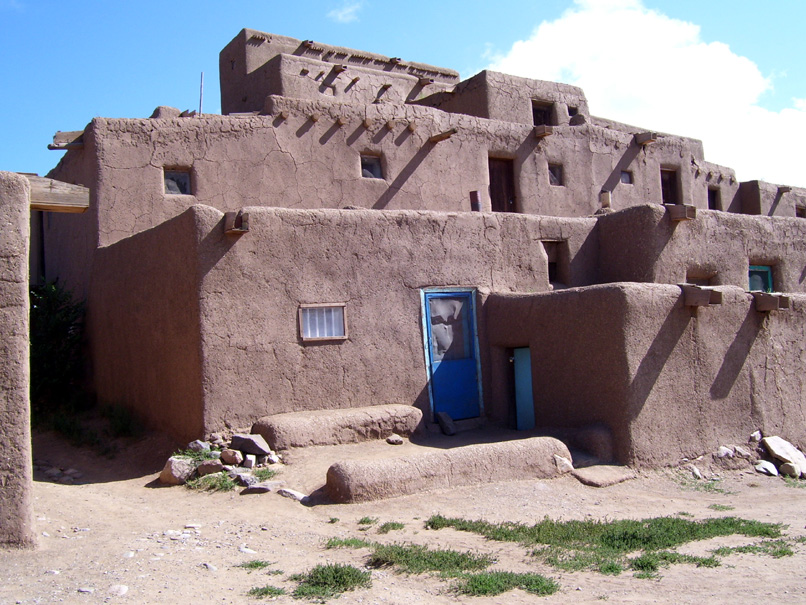
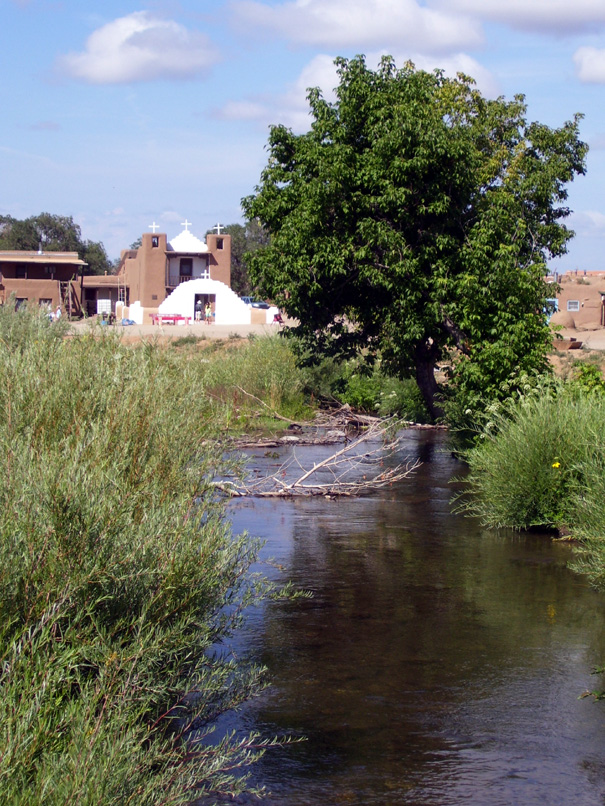 The buildings in the old village have no modern plumbing, no
electricity, and they’re made of authentic adobe, not the Pseudobe used
everywhere else. About 50-60 people actually live in this part of the
pueblo, in houses that have been in their families for hundreds if not
thousands of years. Many of them are simply private residences but many
more have been converted to souvenir shops selling articles made on the pueblo,
authentic foods, etc. to the White Gawkers who have come to see the Simple
Native Peoples in their Idyllic Harmony With Nature.
The buildings in the old village have no modern plumbing, no
electricity, and they’re made of authentic adobe, not the Pseudobe used
everywhere else. About 50-60 people actually live in this part of the
pueblo, in houses that have been in their families for hundreds if not
thousands of years. Many of them are simply private residences but many
more have been converted to souvenir shops selling articles made on the pueblo,
authentic foods, etc. to the White Gawkers who have come to see the Simple
Native Peoples in their Idyllic Harmony With Nature.
Our guide was a very handsome and well-spoken young man in his early 20's who was studying at a university (Art, what else?) but who was articulate, knowledgeable, and a full-blooded member of the tribe, destined some day (when his grandfather died) to become an Elder on the Tribal Council. No defensiveness in him, either: he was proud of his people and their history, and made no bones about it, but neither did he shove it down your throat. If the Indian schools he attended could produce such a fine product through their basic education program, I have to wonder what we White Invaders are doing wrong, because I haven't encountered many 20-somethings who were nearly so well-spoken and polite among the recent products of our schools.
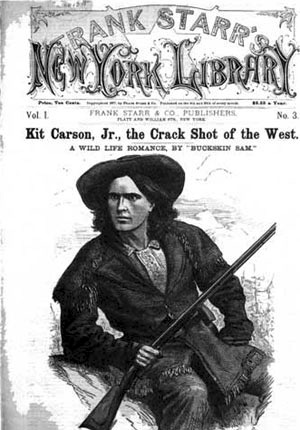 After two days in
After two days in
I was surprised to learn that
Santa Fe
has an architectural standards ordinance that requires virtually all new
buildings to be constructed in "Adobe Renaissance" style. Hence
all buildings look pretty much alike: sort of pinky-brown, with rounded corners
and edges, much like what we saw on the
Shopping centers are made of Pseudobe; fast-food restaurants (I swear it, even McDonald's) are made of Pseudobe (I thought it worked well for the Taco Bell, actually); Wal-Marts are made of Pseudobe, and of course everyone's private home and/or apartment buildings are made of Pseudobe. I don't know how Carolyn and her husband find their house, it's indistinguishable from all the other houses in their subdivision. If they took the numbers off the mailboxes, no one could find his way home.
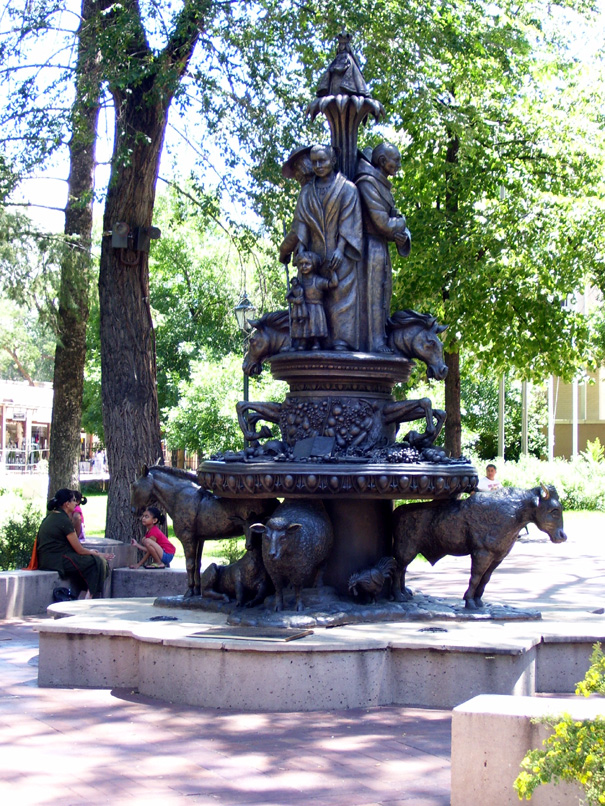
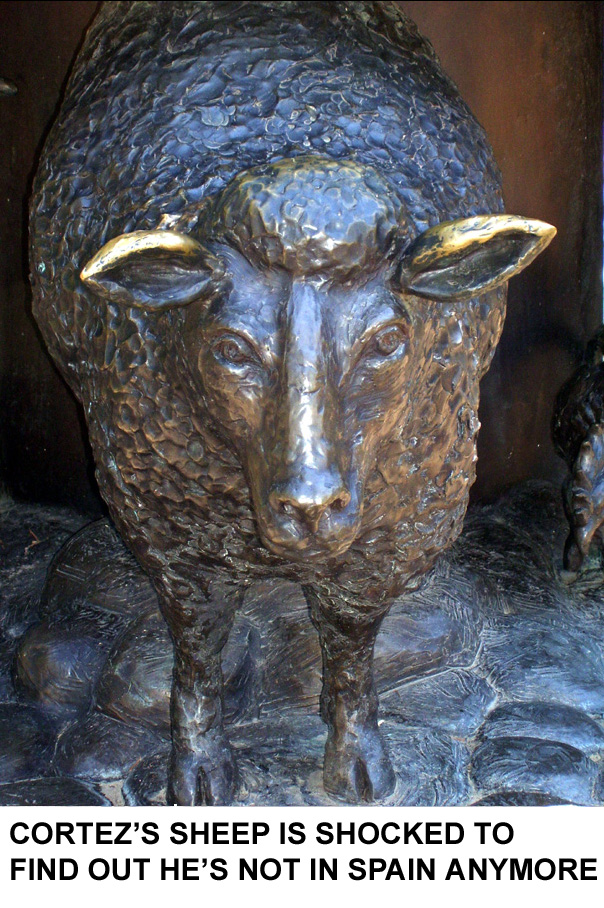 The core of Santa Fe is The Plaza, ringed with gift shops, Art galleries,
jewelry stores, and on one side the Governor's Palace, dating back to Spanish
colonial times and allegedly the oldest public building in continuous use in
the USA (Santa Fe isn't the oldest city in North America—that's St Augustine,
FL—but it claims to be the oldest capital city in North America and it may be right.) The Plaza is a nice green
square with some statuary commemorating the Spanish and the animals they brought
to the
The core of Santa Fe is The Plaza, ringed with gift shops, Art galleries,
jewelry stores, and on one side the Governor's Palace, dating back to Spanish
colonial times and allegedly the oldest public building in continuous use in
the USA (Santa Fe isn't the oldest city in North America—that's St Augustine,
FL—but it claims to be the oldest capital city in North America and it may be right.) The Plaza is a nice green
square with some statuary commemorating the Spanish and the animals they brought
to the
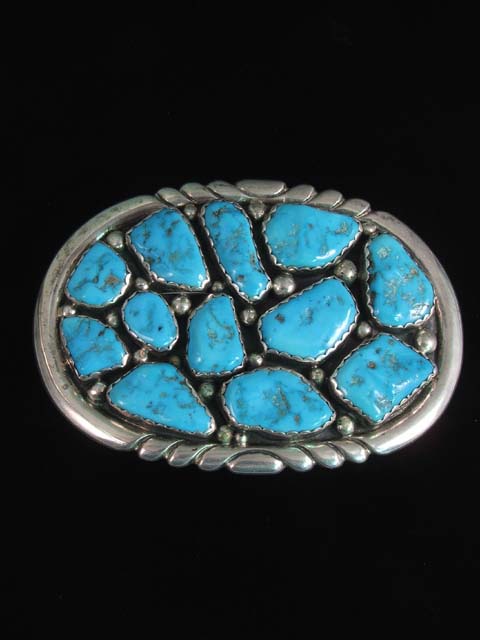
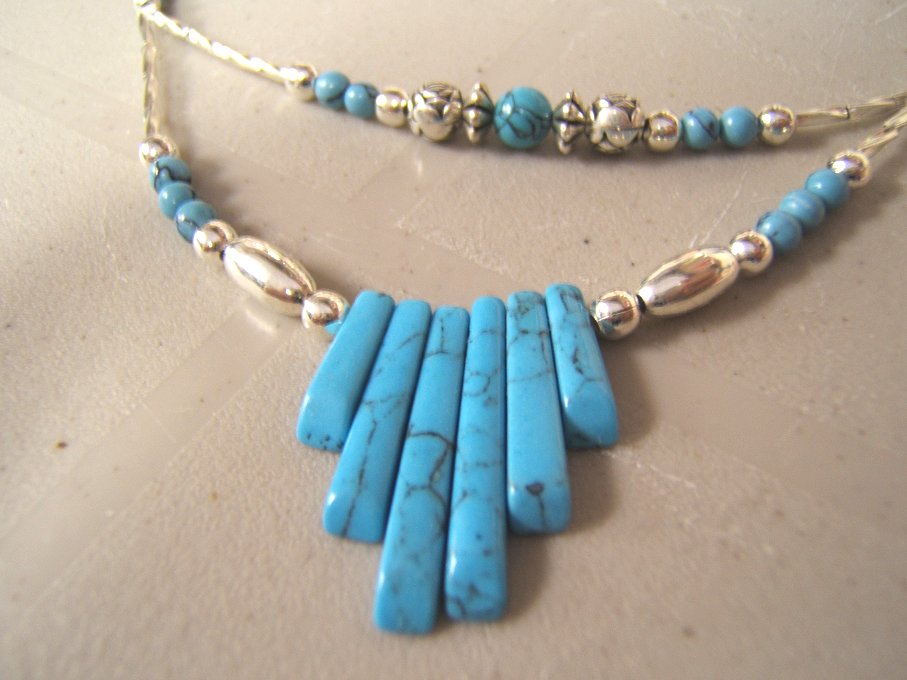 Santa Fe and to a lesser extent,
Santa Fe and to a lesser extent,
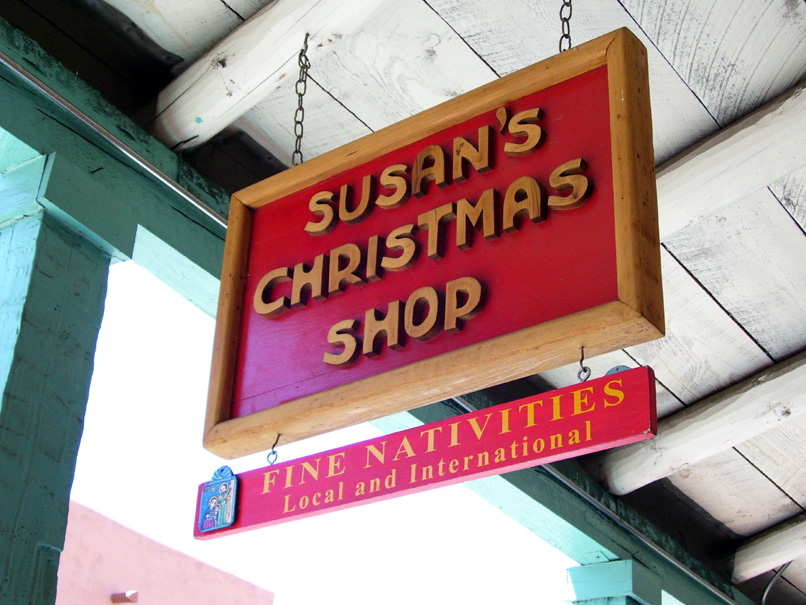 Under the actual Governors' Palace arcade, however, the vendors are all
allegedly Authentic Native Americans selling their own Authentic Native American Handicrafts. Susan
bought a bracelet for herself from one of the putative Indian vendors, and also
a pair of Santa Clauses made from chili peppers, at a place named (I swear it) "Susan's Christmas Store."
Under the actual Governors' Palace arcade, however, the vendors are all
allegedly Authentic Native Americans selling their own Authentic Native American Handicrafts. Susan
bought a bracelet for herself from one of the putative Indian vendors, and also
a pair of Santa Clauses made from chili peppers, at a place named (I swear it) "Susan's Christmas Store."
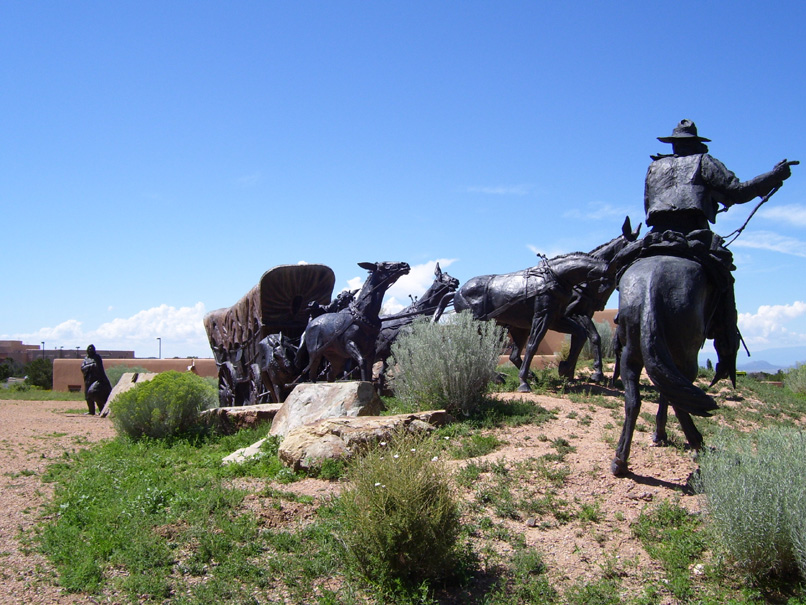 We'd done a tour-bus ride around town the first day to get an eye for the lay
of the land. We saw the "End of the Trail" statue at the place
where the Old Santa Fe Trail terminated, and a bunch of other stuff.
Using that as a basis for The List, we began Day Two by ticking things off: the
Loretto Chapel with its "miraculous" unsupported two-spiral
staircase, the Cathedral that would have had spires like Notre Dame's had Father Lamy not run out of money, and similar stuff.
We'd done a tour-bus ride around town the first day to get an eye for the lay
of the land. We saw the "End of the Trail" statue at the place
where the Old Santa Fe Trail terminated, and a bunch of other stuff.
Using that as a basis for The List, we began Day Two by ticking things off: the
Loretto Chapel with its "miraculous" unsupported two-spiral
staircase, the Cathedral that would have had spires like Notre Dame's had Father Lamy not run out of money, and similar stuff.
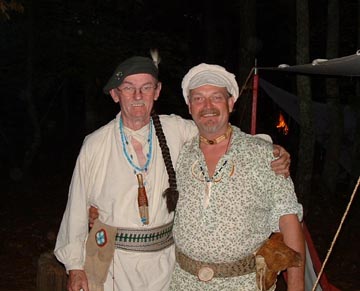 One day we visited Governors' Palace, which was indeed interesting, if a little
disorganized with respect to exhibits and narration. Even better, in the center courtyard, there was a "Mountain Man Swap Meet,"
which was great fun. About 40-50 guys in Funny Clothes displaying their crafts and
their wares for sale, and doing their Living History Thing. One young woman, demonstrating how to scrape an elk hide was
entirely dressed in skins, and cut a very fine figure in them, I might add; but
damn, it was hot that day. She probably omitted the Traditional Indian Buckskin
Underwear, or she’d have died for sure.
One day we visited Governors' Palace, which was indeed interesting, if a little
disorganized with respect to exhibits and narration. Even better, in the center courtyard, there was a "Mountain Man Swap Meet,"
which was great fun. About 40-50 guys in Funny Clothes displaying their crafts and
their wares for sale, and doing their Living History Thing. One young woman, demonstrating how to scrape an elk hide was
entirely dressed in skins, and cut a very fine figure in them, I might add; but
damn, it was hot that day. She probably omitted the Traditional Indian Buckskin
Underwear, or she’d have died for sure.
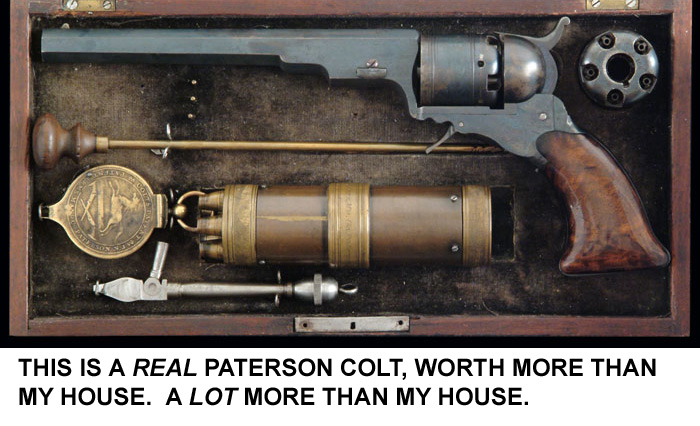 And then there were the guns.
A lot of the buckskinners had brought guns to sell: rifles, shotguns, and
handguns. These were mostly, but not all, black powder flint or
percussion guns. I started dickering with a guy for a .36 caliber Uberti Paterson
Colt replica, under Susan’s disapproving stares, but after schlepping around
after her in about 200 gift shops and buying two red-pepper Santa Clauses, I was going to at least look at the guns. In the end I opted out because his price was
$100 more than I was prepared to pay. I also eyeballed a really fine
M1858 Remington that had been "faked" by removal of the Italian
markings and "aged" so that it looked authentic. It looked so
damned authentic it would have fooled anyone who wasn't pretty conversant with
the characteristics of the Italian guns. The dealer was open about its nature
as well, which in my experience isn’t always the case. I
mentioned to one buckskinner that I knew I was in the West, because it would have been inconceivable to see these things
on sale on government property, anywhere east of the
And then there were the guns.
A lot of the buckskinners had brought guns to sell: rifles, shotguns, and
handguns. These were mostly, but not all, black powder flint or
percussion guns. I started dickering with a guy for a .36 caliber Uberti Paterson
Colt replica, under Susan’s disapproving stares, but after schlepping around
after her in about 200 gift shops and buying two red-pepper Santa Clauses, I was going to at least look at the guns. In the end I opted out because his price was
$100 more than I was prepared to pay. I also eyeballed a really fine
M1858 Remington that had been "faked" by removal of the Italian
markings and "aged" so that it looked authentic. It looked so
damned authentic it would have fooled anyone who wasn't pretty conversant with
the characteristics of the Italian guns. The dealer was open about its nature
as well, which in my experience isn’t always the case. I
mentioned to one buckskinner that I knew I was in the West, because it would have been inconceivable to see these things
on sale on government property, anywhere east of the
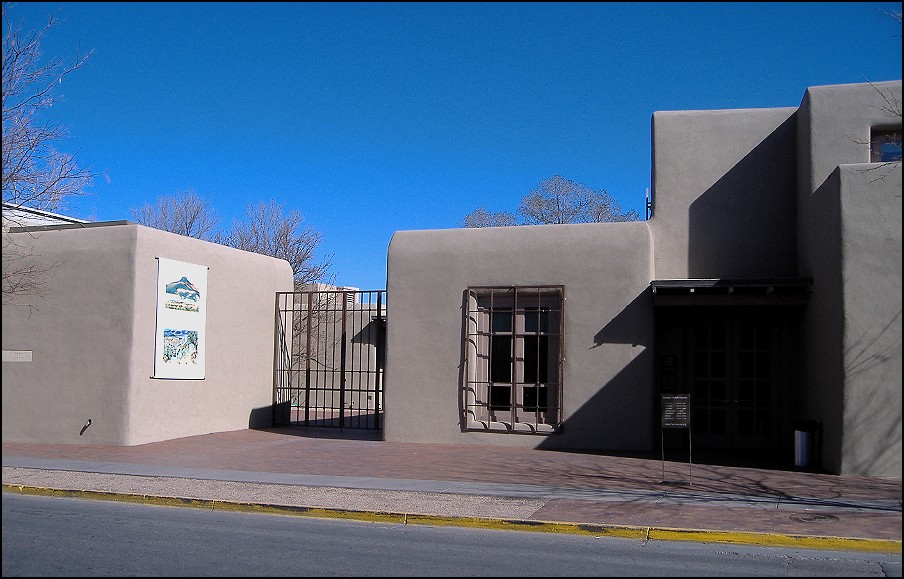
Of course, we HAD to go to the Georgia O'Keefe Museum. To be honest I was
surprised to find that GOK wasn't being touted all over town: she has to be the
most famous figure associated with 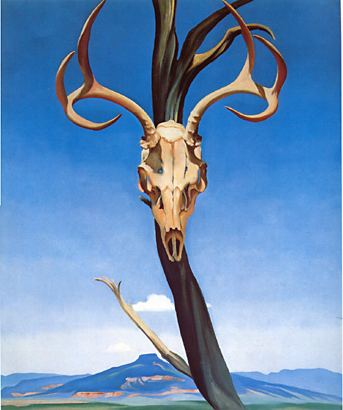 don't.
don't.
I have no idea why she's so revered: I've seen paintings as good or better than hers at any street festival I've ever been to, her abstracts are pedestrian and about as subtle as a brick in the back of the head, and her representational pieces are representative of…well, I’m not sure what they represent. I mean, painting cow skulls is all very well, but painting cow pelvises and what you see through a cow pelvis when it’s sitting on the sand…it just doesn’t speak to me, I’m afraid.
It's also clear from the secondary exhibit of photos of GOK herself that she had a monumental ego, one to dwarf that of Bill Clinton. Why the museum hasn't commissioned a 19-foot-tall bronze statue of GOK, done in Socialist Realism Style, is beyond me: she'd have approved heartily, as nothing more than her due respect.
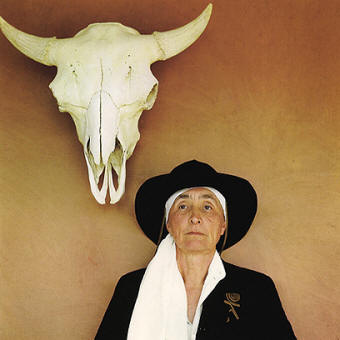 Speaking of Socialist Realism, we spent a half-day walking up
Speaking of Socialist Realism, we spent a half-day walking up  What-It's-Supposed-To-Be galleries, hundreds of them, each one more
expensive than the last. One of these is devoted entirely to
"Russian Moderns," among which school of painting the Soviet Realism
influence is obvious. I saw one portrait of a very fetching young woman
(presumably Russian) that was every bit as realistic and as well-done as a
Coca-Cola advertisement or a Portrait Of A Heroic Labourer For the Motherland
except the subject was a Babe in shorts, and if she'd been working for The
Motherland it would have been as a KGB "Swallow," if you get my
meaning. It was priced at $85,000. The owner/manager of this gallery was gushing in her enthusiasm for Russian
Modernism, and was taken aback when I interrupted her Ode To Russian Art by asking if she had any Native American Matrioshka dolls. Mrs NRVO later told me I had probably offended her, imagine that.
What-It's-Supposed-To-Be galleries, hundreds of them, each one more
expensive than the last. One of these is devoted entirely to
"Russian Moderns," among which school of painting the Soviet Realism
influence is obvious. I saw one portrait of a very fetching young woman
(presumably Russian) that was every bit as realistic and as well-done as a
Coca-Cola advertisement or a Portrait Of A Heroic Labourer For the Motherland
except the subject was a Babe in shorts, and if she'd been working for The
Motherland it would have been as a KGB "Swallow," if you get my
meaning. It was priced at $85,000. The owner/manager of this gallery was gushing in her enthusiasm for Russian
Modernism, and was taken aback when I interrupted her Ode To Russian Art by asking if she had any Native American Matrioshka dolls. Mrs NRVO later told me I had probably offended her, imagine that.
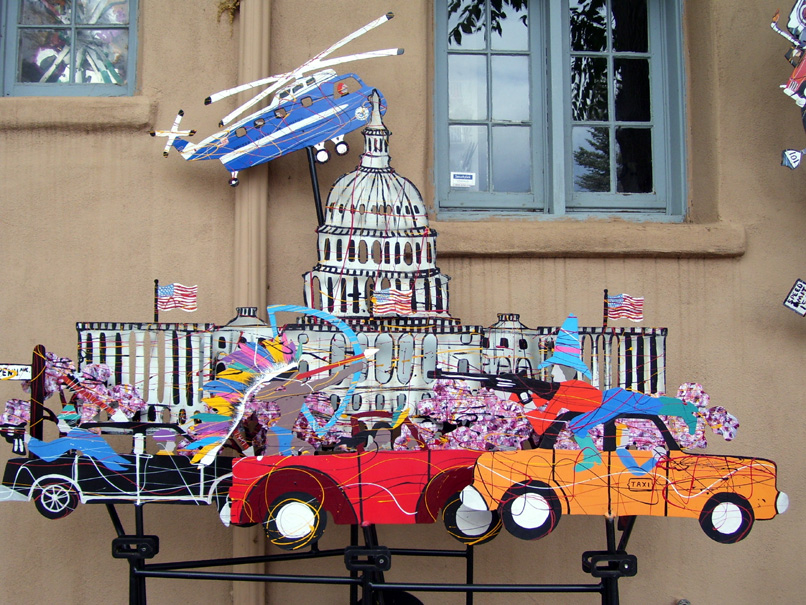 If
If
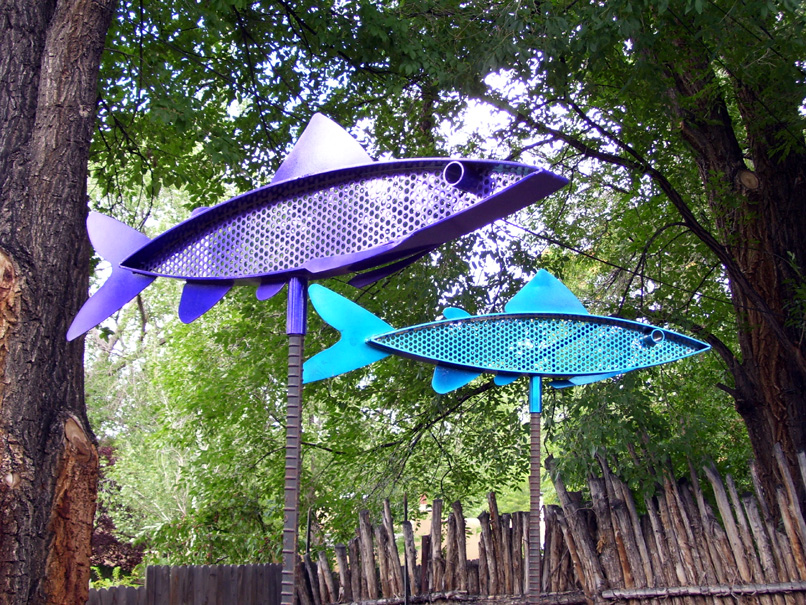 Santa
Fe is "The second largest Art destination in the world in
sales, after
Santa
Fe is "The second largest Art destination in the world in
sales, after
There is
indeed every variety of Art a man could wish, from very realistic sculpture
(there's so much sculpture on sale that there 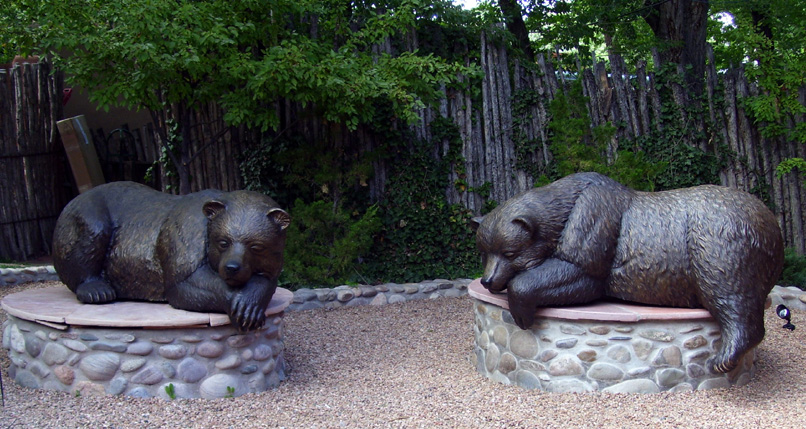 simply has to be a huge foundry
somewhere on the outskirts of town, doing nothing else) to abstracts worthy of
the Hirschorn Museum; paintings ranging
simply has to be a huge foundry
somewhere on the outskirts of town, doing nothing else) to abstracts worthy of
the Hirschorn Museum; paintings ranging 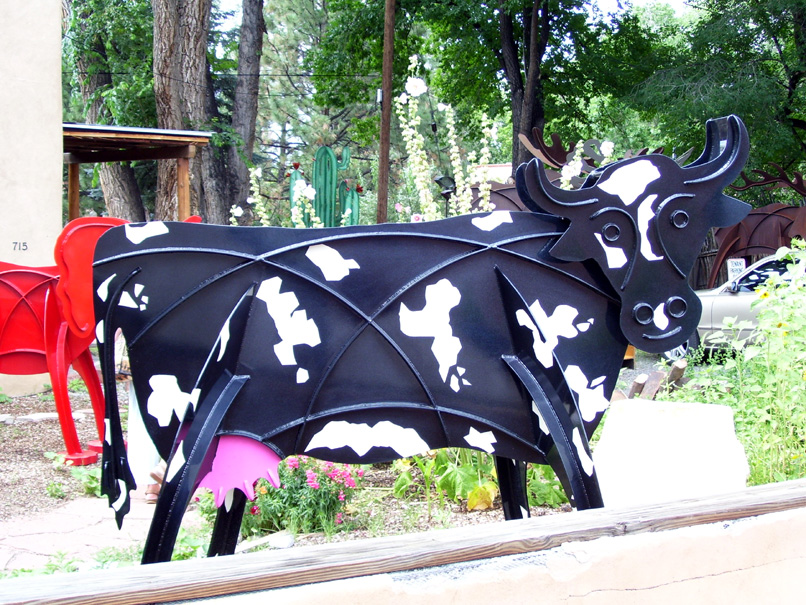 the gamut from Complete Abstract to
gum-wrapper cartoons, and as mentioned, Socialist Realism clones. Leaving
aside the billions of dollars' worth of jewelry that's sold in Santa Fe
every year, the Art sales by themselves probably exceed the Gross National
Product of most countries in the southern hemisphere or eastern Europe.
the gamut from Complete Abstract to
gum-wrapper cartoons, and as mentioned, Socialist Realism clones. Leaving
aside the billions of dollars' worth of jewelry that's sold in Santa Fe
every year, the Art sales by themselves probably exceed the Gross National
Product of most countries in the southern hemisphere or eastern Europe.
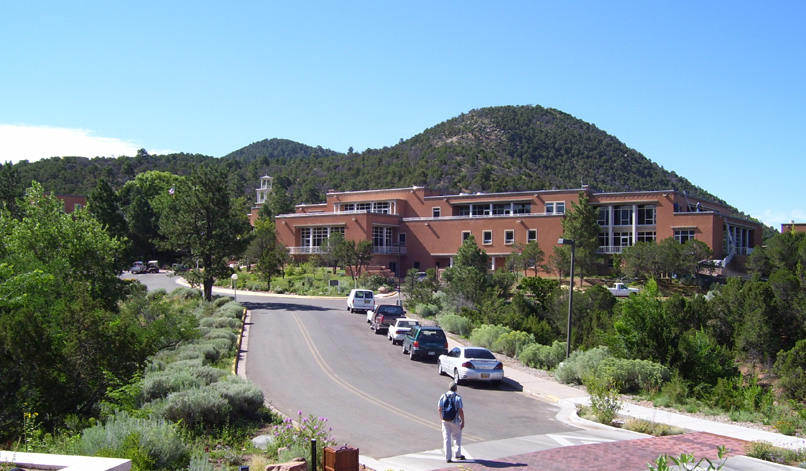
 We visited
We visited
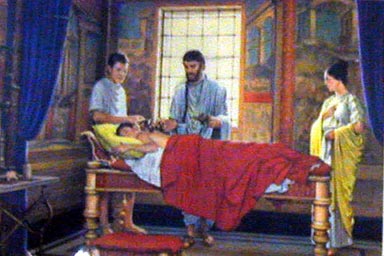 Speaking as a life sciences professor who sometimes despairs
at the ignorance of modern students of the classics, I have some sympathy for
what St John’s is trying to do, and if I had my way, I’d develop a program
under which they’d go through 4 years of The Great Books, so as to become
genuine Scholars who "know how to learn"; and THEN put them into a
5-year European-style professional curriculum in, medicine or something similar.
God knows I'd love to have some of those in my first-year DVM classes.
But turning these poor babies loose on the world knowing a lot about Hegel and
Schopenauer and Herodotus, but nothing about Mussolini, Einstein, or Saddam
Hussein (to say nothing of Watson and Crick or even Darwin) is...ummm...doing
them a disservice.
Speaking as a life sciences professor who sometimes despairs
at the ignorance of modern students of the classics, I have some sympathy for
what St John’s is trying to do, and if I had my way, I’d develop a program
under which they’d go through 4 years of The Great Books, so as to become
genuine Scholars who "know how to learn"; and THEN put them into a
5-year European-style professional curriculum in, medicine or something similar.
God knows I'd love to have some of those in my first-year DVM classes.
But turning these poor babies loose on the world knowing a lot about Hegel and
Schopenauer and Herodotus, but nothing about Mussolini, Einstein, or Saddam
Hussein (to say nothing of Watson and Crick or even Darwin) is...ummm...doing
them a disservice.
St John's is said to produce the best-educated waiters in the world, and so far as I can tell from the curriculum outlines I saw, this would surely be true. If you were a restaurateur who needed a waiter able to discuss Plato’s Cave or Kant’s Critique of Pure Reason with diners, you’d be on the lookout for a recent
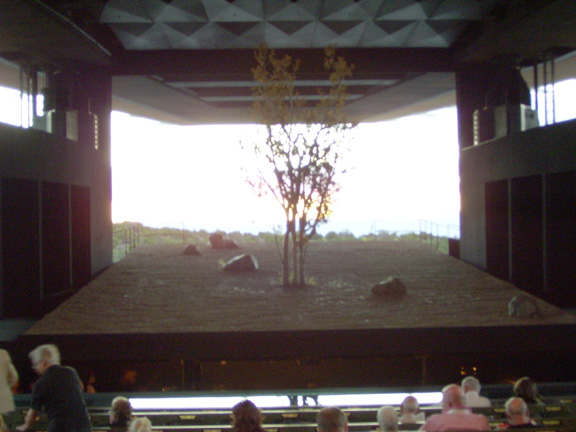
The last day we went to the Santa Fe Opera. Now, I know many people don't like
opera, and I expect most of those who don't have never been to a live production. Opera on stage is an entirely different proposition
from opera recordings, and I never miss a chance to attend a live performance,
even at the ruinous prices SFO charges for seats.
The SFO’s setting and facilities are incomparable. The amphitheater is
more or less outdoors (there's a roof with acoustic tiles but no walls) and you
look THROUGH the stage to the mountains west of town, where the sunsets are
nothing short of spectacular. On one side of the facility you can watch
the spectacular sunsets; on the other you can see the blood-red color that
sunset imparts to the Sangre de Christo mountains. Really impressive, I must say. People who attend the SFO wear everything from
jeans and cowboy boots to tailed coats and tiaras, so I was pretty much in the
middle of the pack dress-wise.
Performances begin at sunset because the lighting
technicians can’t compete with the sunset that you can see from your seat, so
they have to wait until dark. We saw Daphne, a Richard Strauss work from the mid-1930's. Strauss had to live in Nazi Germany so he was
being very careful when he wrote it to avoid offending Hitler and his gangsters. It’s been described in opera guides as “a
bucolic tragedy in one act,” and so it is. While Daphne is a more or less inconsequential opera with a plot that's
even sillier than most, the SFO cast was excellent, the staging simple but
elegant, and the performance as a whole very, very well done.
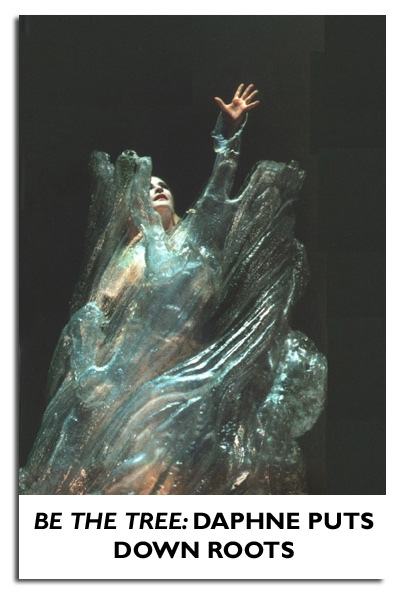 The story is that of a simple, good hearted girl who Loves Nature, and who
lives at the base of
The story is that of a simple, good hearted girl who Loves Nature, and who
lives at the base of
Along comes Apollo, who has fallen in love with Daphne, himself. Being a
god, Apollo naturally chooses to appear to Daphne in disguise, that of a simple
herdsman. He woos her, promising that if she hitches up with him she will
ride his chariot and never see the night again. This suits Daphne just
fine, but then she finds out that Apollo's interest don't just include having
her ride in his chariot, but to...ahem.."ride" Daphne herself, if you get my meaning. Of course, the eternally chaste and totally asexual Daphne is aghast. She
rejects Apollo's advances.
Just then there is a village festival, during which Leukippos appears in drag,
hoping to win Daphne's love by pretending to be a girl.
(I told you the plot was silly.) Apparently Daphne doesn't swing that way,
either, so it's to no avail. Apollo is also at the festival, though the simple, happy peasants don't realize who he is. Nor does Leukippos, but of course, Apollo,
being divine, knows perfectly well that that “girl” isn’t a girl, it’s Leukippos, and exposes him as being in drag.
Once unmasked and mocked by Apollo, Leukippos becomes outraged
that Apollo is trying to steal Daphne's affections and...ahem..virtue. He still doesn’t know who he’s tangling with,
though, and despite several warnings from the god,
Leukippos gets into a fight with Apollo. This is most
emphatically not a good thing to do if you are a mortal, since Apollo
isn't. Apollo (still disguised as a herdsman) kills Leukippos.
Daphne, having finally figured out that she passed up a Good Thing in rejecting
Leukippos, begins wailing her agony at his death, not that it does Leukippos
any good at that point. Apollo,
chastened and guilty—not at having killed Leukippos, but for having upset Daphne—decides
to make amends. Since he knows she loves trees (she told him that when
she rejected his advances) he does so by turning her into...a tree. No
kidding: in the final scene, Daphne climbs into the tree on the set, and the
lighting transforms her into part of it, even as more trees spring up
(literally) from the stage. Presumably this
indicates that the Daphne Tree is sending out shoots. Finis, curtain,
bravo, time to leave, it's 10:45 PM and we have to get
back to the hotel.
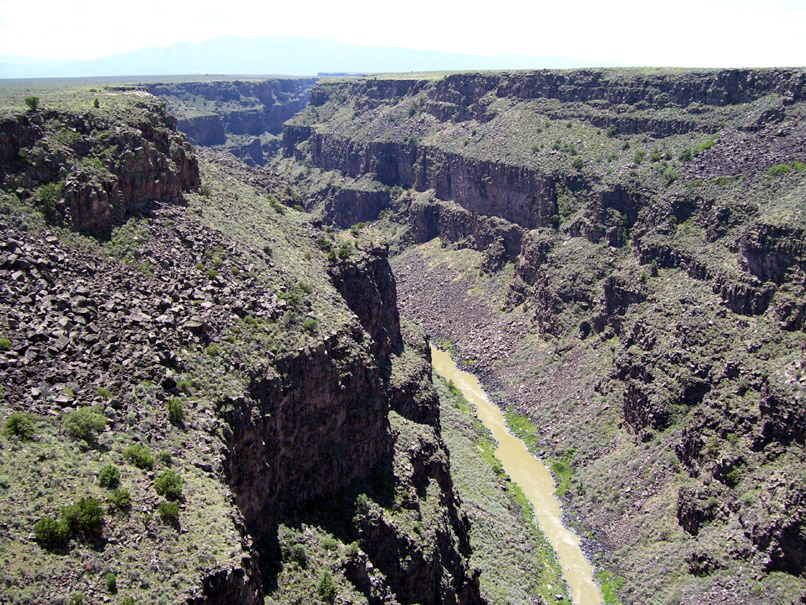
We
drove 868 miles in that week, one time going out to the bridge that crosses the
Rio Grande Gorge (a 600-foot deep chasm that scares the wits out of you when
you think how easy it would be to fall into it). We went to a few
wineries (I didn't even know there were wineries in
Unfortunately we timed our visit to
Then there was the spa.
Susan had found out about a spa called Ojo Caliente, about an hour of
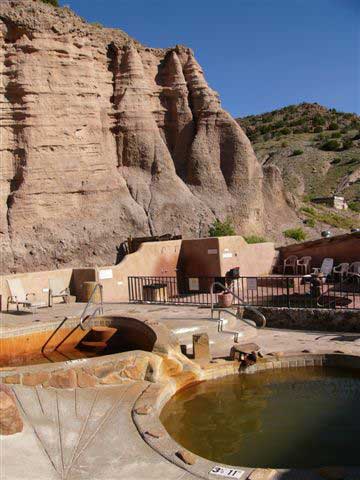 Now I'm not a particularly "skeevy" person. I will go in the
ocean and wade in the
Now I'm not a particularly "skeevy" person. I will go in the
ocean and wade in the
Nevertheless, she was willing to do something I wouldn't have done: get into
what amounted to murky bathwater, along with 50 or 60 total strangers whose
medical histories, diseases, and backgrounds were unknown. New Age
"health resort" or not, the Ojo Caliente Spa is the most unhygienic
place I can imagine. The coolest "pond" was 90+ degrees; some
were up to 107 degrees. Just perfect for incubating
infectious organisms. There were kids in these pools, and no one can make
me believe that a 9-year-old boy immersed in hot water will not, at some time,
pee in it surreptitiously. Nor can I be convinced that everyone did in fact, as
the rules demanded, take a shower before entering the pools.
I flatly refused to do more than dangle my legs in one pool, spending three
hours watching her expose herself to miscellaneous loathsome diseases.
Eventually I had a massage, from a muscular gay guy who practically pulled my
legs off. He also played flute music and used oils that left me smelling like a
cake of urinal deodorant. He was deeply disappointed when he didn't get a
tip, but I maintain that any time I've had to pay nearly a C-note to be
physically pummeled and stretched out like a dead toad on asphalt, well, he's just going to have to settle for his cut from
the spa operator.
| HUNTING | GUNS | DOGS |
| FISHING & BOATING | TRIP REPORTS | MISCELLANEOUS ESSAYS |
| CONTRIBUTIONS FROM OTHER WRITERS|
| RECIPES |POLITICS |